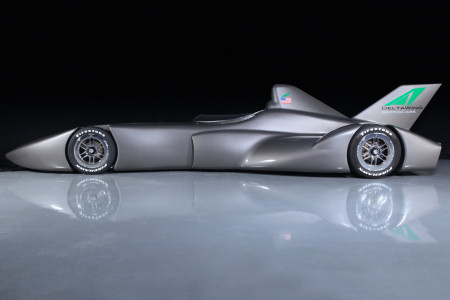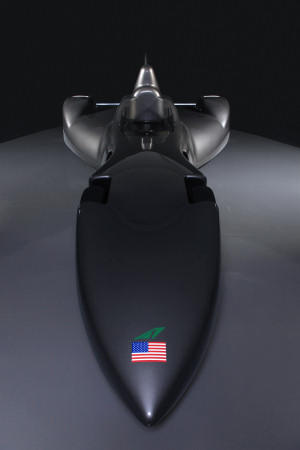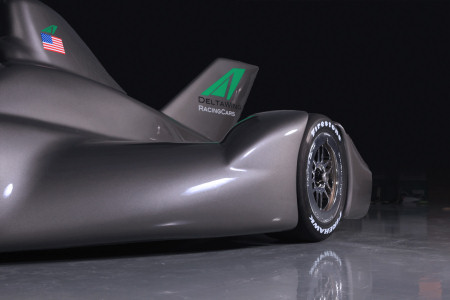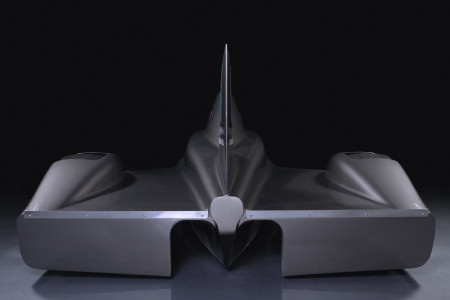The Way It Is/ How the Delta Wing will come to life
by Gordon Kirby This week I'm going to look at how the Delta Wing Indy car will be manufactured. The prototype will be ready for testing in August and if testing goes well the Delta Wing's prime motivators Chip Ganassi and Ben Bowlby hope not only that the IRL will sanction the project but that multiple manufacturers will step up to build competing versions of the Delta Wing design.
This week I'm going to look at how the Delta Wing Indy car will be manufactured. The prototype will be ready for testing in August and if testing goes well the Delta Wing's prime motivators Chip Ganassi and Ben Bowlby hope not only that the IRL will sanction the project but that multiple manufacturers will step up to build competing versions of the Delta Wing design.
"We're looking forward to building the prototype," Ganassi says. "A lot of the owners have put money up and we're on the cusp of getting some matching money from the government to help us build the prototype. We feel pretty good about being able to produce a prototype in six months.
"For the people who have taken the time to sit down and listen to the concept there's a lot of interest from a lot of different angles. We think the car can be built in Indianapolis. The technology and capability is there to do it. Maybe some of the current people in race manufacturing can be involved. We're not trying to exclude anybody in the process. Again, it's not this car against that car. It's not Delta Wing versus Dallara versus Lola. It's something that's all-inclusive."
Delta Wing designer Bowlby says the prototype will be built almost entirely in Indiana and will be tested thoroughly before any production cars are built.

© DeltaWing Racing Cars
"We're going to use local suppliers, most of them in the Indianapolis area. Some are slightly further afield in other parts of Indiana and beyond to build the prototype parts to our design. We'll bring together the car from subcontracted parts but we will do the design of the prototype. We'll probably end up making two or three prototypes."
Bowlby is delighted with the interest shown by potential equipment and technology suppliers from the Midwest and Indiana in particular.
"Some of the companies we're talking to are very significant corporations who want to showcase some of their technology and how it can be applied to the future automotive industry, particularly in the lightweight structures area," Bowlby notes.
Bowlby acknowledges it will take a little time to reignite the local supply chain for Indy car racing.
"Because we haven't built anything new in some years we're out of practice at accessing the cottage industry in and around Indianapolis. We need to get together the same sort of cottage industry that surrounds Lola in the UK and Dallara in Italy and get that industry running smoothly. The prototype will teach us about how to interact with the local supply chain and how we should go about our bidding process and in general get us up to speed on the business side of making this car a reality."
Bowlby emphasizes that new American suppliers and technologies will be essential to the Delta Wing project.

© DeltaWing Racing Cars
"For example," Bowlby goes on, "the composite fuselage and wing structures for the Boeing 787 Dreamliner and Joint Strike Fighter are made by CNC machines that lay unidirectional carbon fiber by an incredible machine that looks like a snake. It's a totally automated process done with incredible precision and these machines are made not a stone's throw from Indianapolis. This is the sort of technology that may well in the future be applied to lightweight structures on road vehicles.
"There are materials that have been developed in the United States that are fully recyclable and have incredible energy-absorbing capabilities and are fire-retardent and used extensively by the military and not at all high cost that we can incorporate in a racing car chassis structure. We're talking about some polypropolene/carbon sandwich structures that have great anti-penetration properties and are highly recyclable and cost a lot less than the systems we are using at the moment.
"There are huge opportunities to use these materials and for them to showcase applications that were designed for aerospace that are now being introduced into the auto industry. We've discovered some very cool things that are possible that no other racing car manufacturer has ever looked at."
Ganassi and Bowlby hope the Delta Wing project will bring a new era of vitality to Indy car racing propelled by an 'open source' system.
"We're bringing an open-source way of doing business to the program where any of the current manufacturers, Dallara or Lola or Swift, can be involved," Ganassi says. "It's not a one-make series. This will only be a one-make series on day one with the prototype. Nobody wants a one-make or one-engine series. I don't want to take anything away from Dallara or Honda. They've done a great job. But we want to see competition among car and engine builders so you'll have lots of iterations of the car along the way.
"We hope with the open-source concept we will attract students from all the engineering schools around the world and spark new thought and designs and have a continuing evolution of the revolution. We think what Linux has done can be done in racing."
Bowlby expanded on their plans for the Delta Wing's 'open-source' system.
"We're absolutely dead-set against a one-make formula," Bowlby declares. "As we've learned, the equation of cost versus the marketability or sellability of a one-make formula doesn't work. We think there's also a value question in a completely free formula like Formula One. So what's the middle ground?
"The concept that we have come up with over a long period of time with a lot of detailed study is what we are describing as an open-source, open-access development protocol. Delta Wing is not a racing car constructor and that's not our ambition so the fact that we've designed a car means that we're not concerned about the intellectual property within the car. This car has been done by the teams that are involved in the IRL for the good of the future of the racing that we participate in."
Every detail and drawing of the Delta Wing will be available on-line.
"We're going to publish the entire production design including the computer models of the components, the engineering drawings for the manufacture of those components, plus the parts list, the price structure and suppliers--you name it," Bowlby relates. "The opportunity for teams and suppliers to download those things and either quote against manufacturing those parts, or in the case of a team they might chose to manufacture the parts themselves. This is all going to be out there and available.

© DeltaWing Racing Cars
Rather than being a chassis manufacturer Delta Wing's goal is to act as the quality control house for all the parts and components.
"There's a lot of detail protocol that we've come up with to make the business model work," Bowlby remarks. "For example, every part that goes to a race will have to be inspected for quality assurance and conformity through Delta Wing. That's how Delta Wing will maintain itself. There will be a charge levied for the parts. It won't be a big charge. It'll be enough to sustain the business and that will mean every part will have a unique part number and identifying tag which will allow the tech process to be a very clear and complete black and white process. As long as the parts conform to a published drawing, the car is legal."
Bowlby is delighted that Dan Partel has joined Delta Wing LLC as the company's CEO. Partel founded and ran the European Formula Drivers' Association (EFDA) from 1979-'99 and ended up running almost one hundred championships across Europe in five different classes. Partel joined Lola as president of Lola USA in 1999 and was in charge of selling Lola Champ cars through his retirement in 2004. He also worked with the IRL to get the organization's approval to build Lola IRL cars before Lola's owner Martin Birrane decided to commit to Champ Car rather than build any IRL cars.
"I'm very pleased that Dan Partel has joined us," Bowlby says. "Dan brings incredible experience of lots of different elements of motorsports andd marketing. He's done his time with the multinational corporations and he's done his time running championships and helping run Lola. He has a really good background and his energy for this project is fantastic. He describes this as the most exciting project he's ever worked on and we all feel like that.
"We all feel we're onto something big. It's very different but it's like the time is right and we've got to do it. We've got to take that risk. As Dan says, 'Being safe isn't safe anymore.' We've got to extend ourselves and take the risk, do a great job and good things will happen."
After being a key man in the introducion of spec cars to the lower rungs of racing's global open-wheel ladder system Partel more recently became a leading critic of spec cars infecting the sport's upper categories.
"It's funny," Bowlby remarks, "because Dan's the guy who made spec racing palatable and he now rails against it. But as he says, he never intended spec cars to be the premier forms of racing. It was for the ladder system at the lower levels."
Partel stressed that a key pat of his new job with Delta Wing was insuring the company operates as an independent entity free of any influence from its founding team owners.
"This company has been set up to be a neutral company in the scheme of things in motor racing," Partel said. "My objective is to establish and keep us in a neutral position. While Chip and Ben were the movers behind the concept the plan for the company was to create a separate and independent entity, not something that was a team owners' association in any way. This is an independent design and engineering operation for the benefit of IRL and Indy car racing. It's my job to head this company and make sure that is exactly what it is, although its roots clearly started from Ben's drawing board and Chip's initiative.
"Chip wants to step back and get back to racing and let this entity go on in its own direction. And of course, he wants to get Ben out of the administration and the myriad of details that have to be sorted out from the corporation's point of view and let him get back into the drawing room. My role is to pick up all the non-engineering pieces and pull it together and make it happen.
"I came in here after being inactive for six years and I never was that involved with IRL racing," Partel adds. "My job wth Lola was to get us to the negotiating table and to win the rights to construct IRL cars, and I did that. But Lola opted not to participate in the IRL and that was really the end of my involvement with the IRL. So I came in here in very much of a neutral position and it's my intention to continue that and to take Delta Wing to what it's really intended to be, which is to provide the IRL with an option."
Partel is currently trying to work out an agreement with the IRL that would permit funding for the Delta Wing project from the state of Indiana.

© DeltaWing Racing Cars
"I think we've already achieved one of the first objectives which is that it's all about the car and innovation. There's a tremendous amount of interest in this car, especially from young people, and that's got to be a good thing."
Partel adds that the more people learn about the Delta Wing the more support the concept gathers.
"You guys in the press have done a great job of communicating what the Delta Wing is all about," Partel remarks. "The first forty-eight hours we saw a lot of opposition but that's changed dramatically. We've seen a big change in the level of acceptance and the desire to learn and understand more about the whole concept and you guys have been really helpful in getting the word dout.
"This platform has had such universal acceptance that it's going to be used one way or another somewhere in the world," Partel adds. "It's had much greater acceptance in Europe and around the world than it has in the United States and now that the genie is out of the bottle you better believe there are going to be people looking at how to emulate this."
Partel commented on how the Delta Wing prototype will be built.
"The suppliers and the people required have pretty much been identified and are in various stages of development," Partel says. "The engineers indicate to me that they don't consider it to be a problem. It'll be built locally in Indianapolis. The plan calls for us to develop our own facility. It won't be particularly large. It's not as as if we need a large manufacturing facility. Ben's plan calls for nine people in engineering and we'll bring in a few more people to bolt things together.
"Most of the parts we'll be sub-contracted out and of course we've reduced the number of parts considerably by not having any wings. If you look at a Formula One McLaren I think it has thirty-six components so when you start applying that through the whole car there's quite a reduction in the number of components and that's part of the reduction in the cost.
"I see new technology coming through here every day and it is really impressive. There's some really interesting stuff. This will be new-tech right through the whole car with a lot of cutting-edge stuff. It's very, very interesting. It's all designed to reduce the weight or use new materials or do things in a different way. Some of this is stuff that's never been seen before and should create plenty of stories for you guys to write about."
Partel sees plenty of opportunities for Delta Wing engine suppliers.
"The light weight gives us tremendous flexibility as far as engines and power sources and quite a few manufacturers either have or are working on developing four-cylinder engines that can be used in racing," he remarks. "GM, Ford, Hyundai and the Volkswagen-Audi group is sitting there ready to go with their four-cylinder engines. So I can see Ford, Chevy, Audi, VW, Hyundai and Peugeot when they decide to enter the American market, which they're talking about doing, as possibilities to be in there right out of the box over the first three years."
Indy car racing's most successful team owner Roger Penske is a supporter of the Delta Wing project.
"I'm mostly concerned from the safety standpoint," Penske says. "Once they get that sorted out we'll see what happens. I think the right approach is to help fund it, to build a car that we can test and see its safety aspects."
Penske counsels for caution in introducing the new car.
"Honda's been a big partner and so has Dallara and we don't need a political battle with some car owners wanting a Delta Wing and other owners wanting to stay the traditional way," Penske comments. "I think if we wait a year and push it out to 2013 we can race what we have. We've had good racing and we can keep the costs down especially with the economy the way it is. Then Chip and those guys can get that car developed. Once we get it on the racetrack it's going to be real obvious. I think when that happens they'll either be a lot of support or there won't be.
"At this point I think any new innovation is positive and I think it's important that we evaluate it properly. I think we need innovation. The world is living on innovation and certainly this is an opportunity. What we want to do is evaluate it properly because a knee jerk at this time with a new car and new engines it's going to be expensive. On the other hand it might be something to take Indy car racing where it needs to be."
Ganassi is pleased the Delta Wing has helped bring most of the Indy car team owners together for the first time in many years.
"It's funny when you have Chip and Roger and John Barnes and Dennis Reinbold all on the same page," Ganassi remarks. "It's good because it's brought the ownership together. Also, Tony (George) is a fan of it. I can make the argument that becoming an owner made Tony acutely aware of some of the challenges we face.
"My involvement at this point isn't more or less than any of the other car owners," Ganassi adds. "Eight or ten of the car owners are involved. It's not a Chip-only project by any stretch and it's not something the car owners have any interest in taking over. It's not that at all. Again, we want to see multiple manufacturers engaged in Indy car racing."
A pause for reflection before Ganassi summarizes the Delta Wing project.
"With this car there would be no question about what an Indy car is, would there? It's certainly a departure from the norm and it's hard for a lot of people to digest off the bat. But we think if you take the time to to understand it the concept makes a lot of sense. Certainly Indy car racing needs a shake. Maybe this can do it."
Adds Bowlby: "I view this as quite a large personal risk for me and for Chip and the other team owners involved. But this is the time for this project. I'm prepared to stick my neck out because I think this can be a real game-changer and provide IndyCar an option for the future and perhaps help us have a brighter future."
For my part, I've railed for some time against spec car racing and implored someone in the sport to show some leadership and reintroduce the spirit of innovation to racing. I congratulate Ganassi and Bowlby for pushing the Delta Wing initiative forward and hope the concept can begin to work a transformation of Indy car racing. The sport sorely needs it.
Tune in to Mike Knight's 'The Race Reporters' radio show on Wednesday evening March 3rd at 7 pm. I'll be a guest of Mike's in company with John Oreovicz, the IRL's commercial director Terry Angstad and NASCAR star Jeff Gordon. You can access the show via the web at: www.PowerUpChannel.com.
Auto Racing ~ Gordon Kirby
Copyright 2010 ~ All Rights Reserved
Copyright 2010 ~ All Rights Reserved
Top of Page